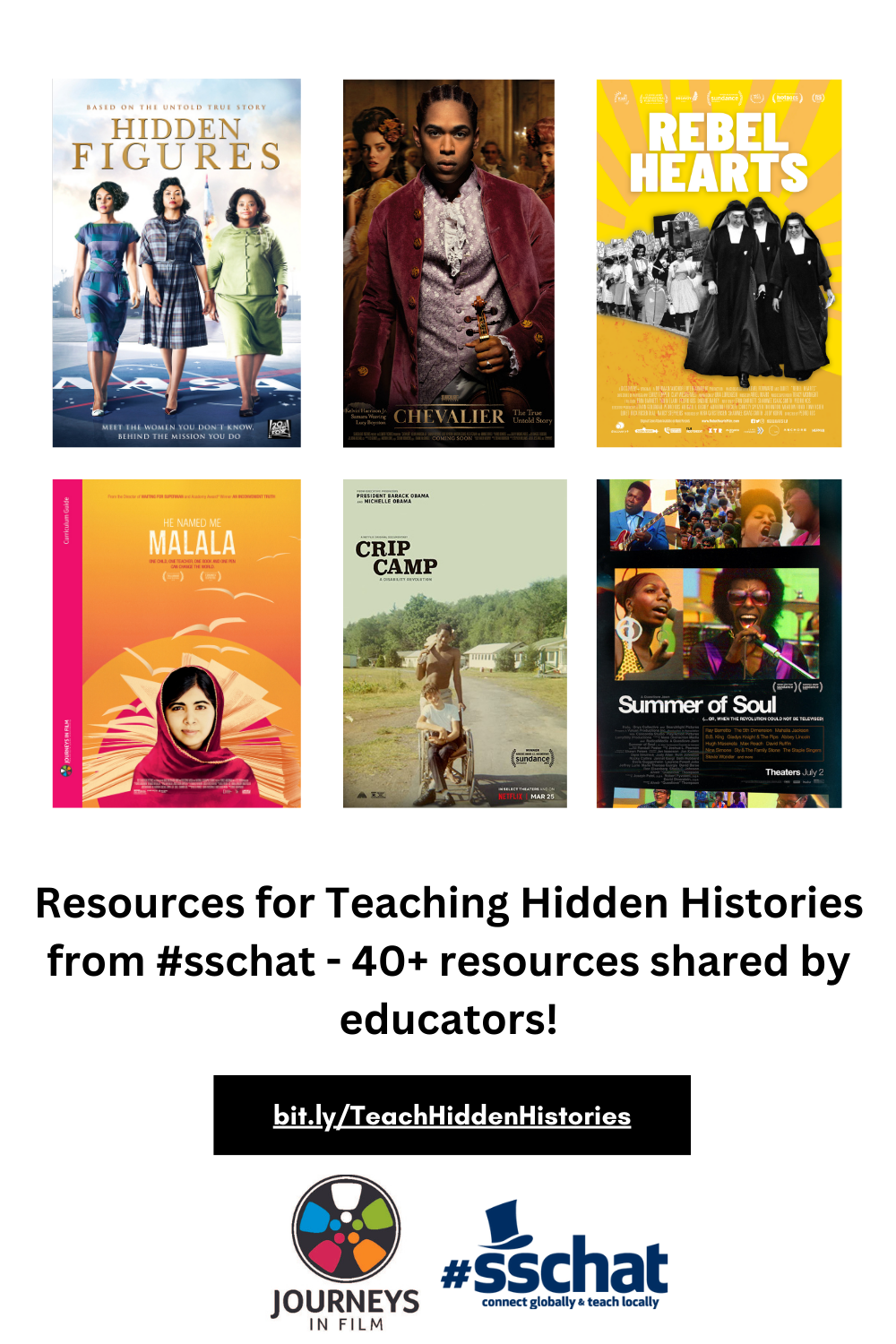40+ Resources for Teaching Hidden Histories – Shared During #sschat
We were honored to host a Twitter chat, #sschat, this summer. Our chat focused on Teaching Hidden Histories. Since Wakelet is no longer available with Twitter (yes, we’re still calling it Twitter), we decided to put together this article for our website compiling resources shared during our twitter chat.
We’ll show the questions we asked in the Twitter chat and then the resources shared in response to that question.
Q1: What historical figures, including lesser known, have excited and inspired your students?
We shared one our newest resources, a discussion guide for the new Searchlight Pictures film Chevalier and our guide for the powerful documentary Rebel Hearts. Both resources are available for free on our website.
Educator’s chimed in and recommended teaching about Fannie Lou Hamer, Diane Nash, and other women of the civil rights movement, which our resource for Rebel Hearts touches on as well. The Children’s March of the Civil Rights Movement was also recommended.
For World History, the Soviet Night Witches of World War II and the Red Bird/Zitkala Sa.
Another educator shared that Pauli Murray and Charlayne Hunter Gault’s autobiographies inspired them to become a teacher.
Other lesser known historical figures shared in the chat were: Clair Cameron Patterson, Molly Craig, Ignacio Lopez, Miss Washington, Vincent Chin, Toussaint Louverture, Sacajawea, Francis Marion, Josiah Chamberlin, and Phyllis Wheatley.

More Resources
Q2: What resources (books, films, websites, podcasts) have you found most useful for teaching hidden histories?
We shared our free core-based resources for many biopics or biographical documentaries, specifically guides for the documentary film, Big Sonia, highlighting a Holocaust survivor’s life and story, Just Mercy, the narrative film about Bryan Stevenson’s life and work with the Equal Justice Initiative and, our most popular resource, our discussion and curriculum guides for Hidden FIgures.
Podcast recommendations in response to this question included: Stuff You Missed in History Class (especially the two part episode on Bayard Rustin, for example), History Extra, Lost Highways (for Colorado History), and Throughline.
Other resources shared: Zinn Education Project, Social Studies School Service, the Library of Congress, We Were There Too: Young People in U.S. History by Phillip Hoose, National Park Foundation, Stanford History Education Group, Facing History and Ourselves, Learning for Justice, Bureau of Labor Statistics, History Skills, British Library, Classroom Tools, Mary Johnson’s website, Re-imagining Migration, Echoes and Reflections, Model Diplomacy, iCivics, Flocabulary, California: A Slave State, Untold History (Youtube channel), Eyes on the Prize (PBS Series) and PBS News Hour Classroom.
State historical societies were also recommended.
POV and Personal Narratives
Q3: Our Discussion Guide for Chevalier provides an opportunity to introduce students to historical figure they have likely not heard of and provide a new point of view on the French Revolution.
Figures and resources shared in response to this question: Phebe Ann Jacobs, the woman whose story inspired Harriet Beecher Stowe to write Uncle Tom’s Cabin; The Time Traveler’s Guide to the Middle Ages, @TheCrashCourse world history episode on WWII where John Green puts forth a thesis that the war was related to food, and @SHEG_Stanford POV lesson of Battle of Lexington ever year.
Q4: What role do you think personal narratives play in teaching students hidden histories? What are benefits to this approach? What are challenges?
We shared that some of the personal narratives from our resources that we’ve seen students respond to include He Named MeMalala and Queen of Katwe, and in general educators shared that they find personal narratives to be quite compelling in the classroom, but also warned that it’s important for students not to assume that one person’s narrative represents all or even all narratives of individuals like them from that time period. This question reminded educators to recommend Story Corps on the chat. The Joads from Grapes of Wrath were mentioned in response to this question too, and this resource from Project Zero was shared.
Music, Art, Science and Social Change
Q5: Throughout history, individuals have used music, science, art, oration, the law, etc. to ignite social change. How can the arts be used to engage students and highlight hidden histories?We shared that the film Chevalier shows the role that music played in French society and the way that racial prejudice limited opportunities. As Chevalier grows and changes, we also see his use of music to support the revolutionary movement in France.
Other Journeys resources we shared included Rebel Hearts and The Boy Who Harnessed the Wind as stories that inspire and excite students.
Educators discussed the power of folk songs, music of the Industrial Revolution, comparing headlines, posters and propaganda from history, this podcast resource from Washington Post, this mural project in Los Angeles, NCMA Learn, the Life of Paul Robeson, and Teach Rock. Defiant Requiem was recommended by an educator as well, which we have a free resource for. Another educator shared that she looks at murals and corridos with her students as they study the Mexican Revolution and use a clip from Cry Freedom and the song “Never Again” by Prophets of da City for teaching about Apartheid.
Educator Favorites
Q6. Personally, what’s YOUR favorite “hidden history” to teach?
We shared that Hidden Figures is the most popular “hidden history” downloaded from our site with Summer of Soul also popular and that we love Crip Camp.
Popular shares on Twitter during the chat: women’s histories, common soldier accounts from the Civil War, local histories of various historical events, Disability Rights, Roanoke, the Occupation of Alcatraz, Native American/Indigenous History, Claudette Colvin, The Woman Who Would Be King: Hatshepsut’s Rise to Power in Ancient Egypt
